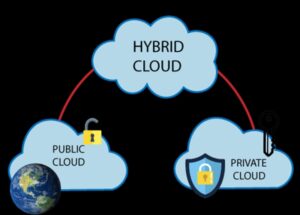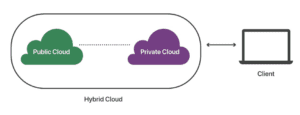What is the hybrid cloud architecture?
Individually managing public and private cloud resources is preferable to uniformly managing cloud environments because it reduces the likelihood of process redundancy. By limiting the exposure of private data to the public cloud, a hybrid cloud architecture can eliminate many security risks. A hybrid cloud deployment infrastructure typically consists of a public infrastructure as a service (IaaS) platform, a private cloud or data centre, and network access. Many hybrid cloud deployment models make use of both local area networks (LAN) and wide area networks (WAN).
What is the purpose of a hybrid cloud?
Hybrid clouds can also be used to create multi-cloud environments, giving businesses more options for where they want their data stored and how they want it accessed. By allowing businesses to back up data in both public and private clouds, a hybrid cloud deployment environment can be beneficial for disaster recovery.
What are the benefits of hybrid cloud deployment?
Governance of applications that works: A hybrid cloud method allows you to choose where your application will run and where hybrid computing will take place (Kaviani, Wohlstadter and Lea, 2014). This can assist to increase privacy while also ensuring compliance for your regulated apps.
Enhanced speed and decreased latency: A hybrid cloud solution might sometimes assist dispersed programmes in faraway regions. Hybrid computing occurs near the end consumers for applications with low latency needs.
Flexible operations: Hybrid computing allows you to function in an environment that is ideal for you. You may, for example, construct portable apps and simply migrate between public and private clouds by creating using containers.
Better ROI: You may increase your cloud computing capacity without raising your data centre costs by adding a public cloud provider to your existing on-premises architecture.

Hybrid Cloud Deployment Models
Hybrid cloud deployment models are classified into three types:
Hybrid cloud deployment model architecture with a phased migration
You migrate applications or workloads from an on-premises data centre to the architecture of a public cloud service provider. This can be done gradually or all at once. This paradigm has the advantage of allowing you to use only what you need, assigning as much or as little as needed for each application or transaction. The negative is that it may not provide you as much control over how things work as if they were on using a private cloud deployment model (Biswas and Verma, 2020).
Hybrid cloud deployment model with apps that are only partially integrated
This concept entails migrating some but not all apps or transactions to the public cloud while maintaining others on-premises. If your organisation has apps that can operate in private cloud deployment model settings or public clouds like AWS or Azure, this is a terrific solution. Based on performance requirements or financial limits, you may determine which ones are a better fit for each case.
Hybrid cloud deployment model with integrated apps
The hybrid cloud strategy with integrated apps entails integrating applications running a private cloud deployment model and in the public cloud utilising PaaS software on the public cloud. The applications on the private cloud deployment model are installed using IaaS software and then integrated into the public cloud using PaaS software.
Is Hybrid Cloud the Best Option for Me?
Hybrid cloud deployments are a popular choice for businesses that want to take advantage of cloud computing’s flexibility and cost benefits while keeping control over their data and applications. To accomplish the intended business objective, hybrid cloud deployment often employs private, public, and third-party resources.
Hybrid Cloud Deployment Environment
The following approaches can be used to deploy hybrid clouds:
Non-critical workloads should be outsourced to a public cloud: You can outsource a mission-critical system that does not require quick response times, such as a human resources application, to a public cloud provider (Sturrus and Kulikova, 2014). This allows you to host and maintain applications on the public cloud while maintaining control over your data.
Use a virtual private cloud to deploy mission-critical workloads: The alternative is to host important workloads in a virtual private cloud (VPC). It is also the most widely used hybrid cloud deployment option since it mixes on-premises infrastructure with public cloud resources.
Dedicated hardware should be used to host the private cloud: Instead of depending entirely on public or private clouds, you host your private infrastructure on the private cloud deployment model’s hardware under this architecture.







